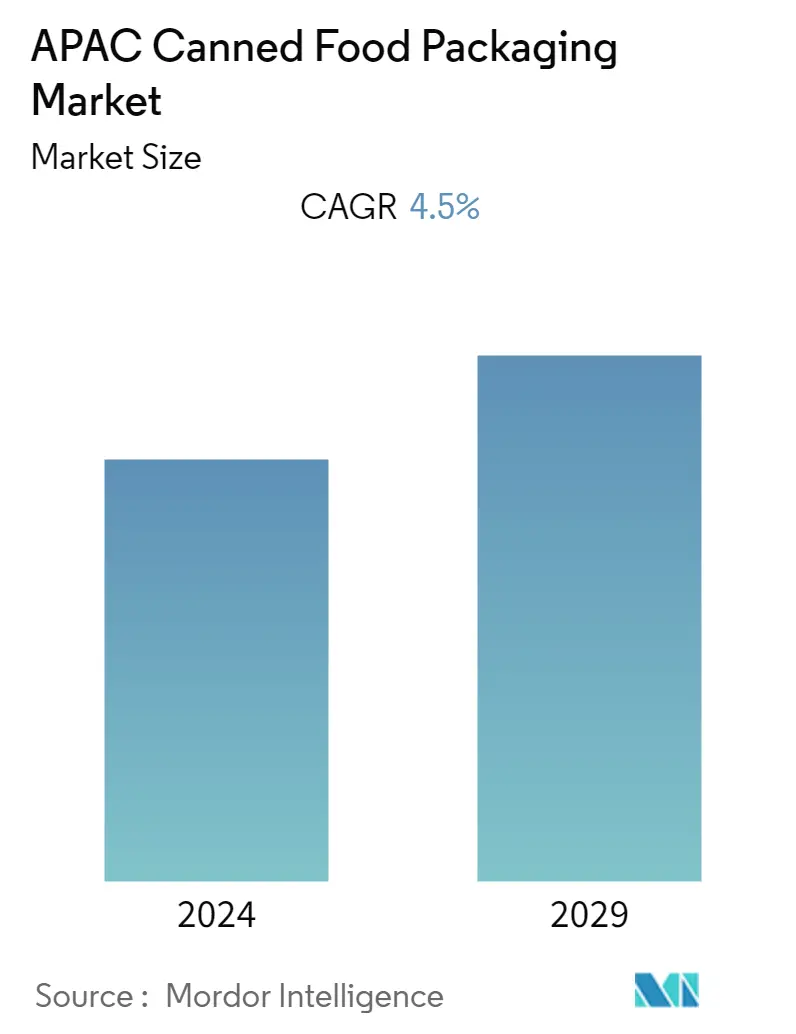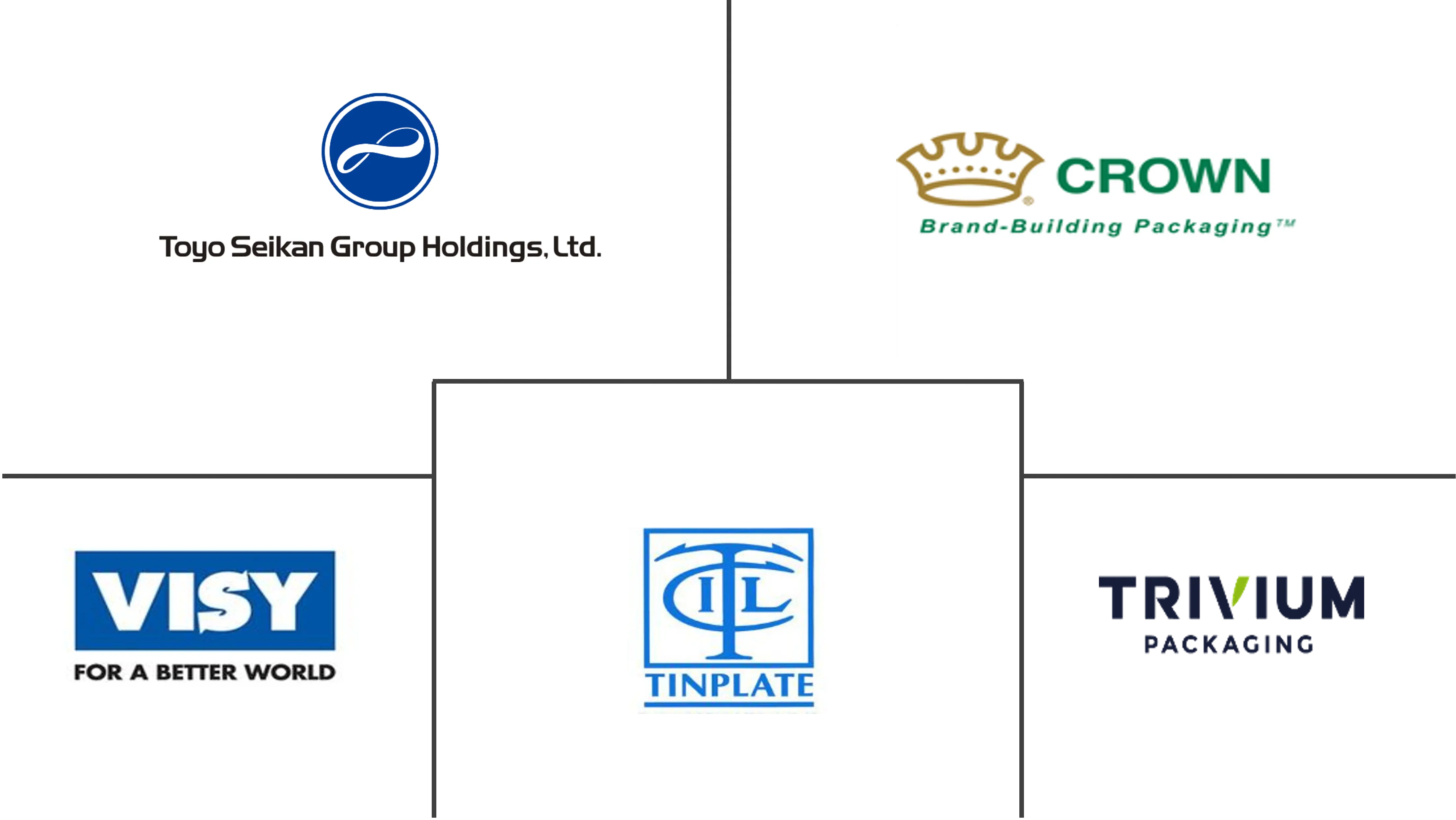Market Size of APAC Canned Food Packaging Industry

| Study Period | 2019 - 2029 |
| Base Year For Estimation | 2023 |
| Forecast Data Period | 2024 - 2029 |
| Historical Data Period | 2019 - 2022 |
| CAGR | 4.50 % |
| Market Concentration | Medium |
Major Players
*Disclaimer: Major Players sorted in no particular order |
APAC Canned Food Packaging Market Analysis
The Asia Pacific Canned Food Packaging Market is expected to grow at a CAGR of 4.5% during the forecast period (2021-2026). Canned foods are preferred more because they are readily available in the market and are an essential part of the diet of many individuals, which will play a key role in boosting the market growth of canned foods. Moreover, as canned foods of good quality are coming up, the demand is further increasing, also bolsters the market.
- Hypermarkets/Supermarkets are the primary channels of distribution of canned food in the region. Wider availability of products under one roof, ranging from soups to meat products, has fueled the growth in the sales channel. Supermarkets sell products at a competitive price to expand their consumer base. Bundling products has been a popular strategy that has promoted the growth of products, such as instant noodles, ready meals, and canned soup. Walmart, Carrefour, Metro Inc., Ito Yokado, AEON, the Tokyu Store, 7-Eleven, and Woolworths are the major superstores in the region.
- Growth in the canned food packaging market is directly proportional to changes in the food industry and the costs associated with packaging. According to Australian Statistics Bureau records, Australia's canned food market has grown significantly, with food retailing up 12% to AUD 151.34 billion. However, increased material costs can hinder the market growth during the forecast period.
- Consumer demand for convenient canned food products that are healthy, ethical, and comforting, and fit for fast-paced life is increasing in developing economies. Moreover, the rise in disposable income in emerging economies such as China, India, and Brazil has increased expenditure on time-saving and labor-saving canned food products. According to the National Bureau of Statistics of China, the annual disposable income per capita of urban households has increased by more than 100% in the last ten years, reaching RMB 43,834 in 2020.
- Southeast Asian countries like Malaysia and Thailand are expected to generate lucrative sale opportunities for canned food products due to the emerging tourism sector seeking packed food, whether metal or steel packaging. Therefore, hotels ensure providing packed canned food, especially canned meat, due to its perishable nature. Airtight packaging brings imperishability, ensures the product's long shelf life, and positively influences canned food demand.
- The spread of COVID-19 spurred the demand for canned food across the Asia Pacific region due to increased dry food procurement backed by hygiene concerns. However, the market cannot wholly capitalize on the sudden demand influx due to a complete lockdown and suspension of the production activities, which hindered the market's growth during the year 2020. Further, since health concerns are likely to be sustained even after the disease outbreak registers slowdown, sustained growth of the market is expected to be witnessed in the coming years.
APAC Canned Food Packaging Industry Segmentation
Canned Foods are a type of food items that have been processed and sealed in an airtight container for preservation to extend the product's shelf life. Canned foods are preferred more because they are readily available in the market and are an essential part of the diet of many individuals. It will play a role in boosting the market growth of canned foods. The market is segmented by raw material, product type, and country.
| By Material | |
| Metal | |
| Steel | |
| Aluminum | |
| Others |
| By Product Type | |
| Readymade Meals | |
| Meat | |
| Sea Food | |
| Fruits and Vegetables | |
| Others |
| By Country | |
| China | |
| Australia | |
| Japan | |
| India | |
| Rest of Asia Pacific |
APAC Canned Food Packaging Market Size Summary
The Asia Pacific Canned Food Packaging Market is experiencing steady growth, driven by the increasing consumer preference for convenient and readily available food options. Canned foods have become a staple in many diets due to their accessibility and the quality improvements in recent years. The primary distribution channels for these products are hypermarkets and supermarkets, which offer a wide range of canned goods at competitive prices, thereby expanding their consumer base. The market's expansion is closely linked to developments in the food industry and packaging costs, with emerging economies like China and India contributing to the rising demand due to increased disposable incomes. Southeast Asian countries are also expected to provide lucrative opportunities for canned food sales, particularly in the tourism sector, where packaged foods are in high demand.
The market is moderately competitive, with major players actively expanding their presence and forming strategic partnerships to enhance profitability. Initiatives like Canvironment week promote the benefits of metal can packaging, highlighting its eco-friendly nature and recyclability. The demand for steel cans remains strong due to their cost-effectiveness and ability to preserve food quality. The COVID-19 pandemic initially boosted canned food sales, but long-term trends may shift as consumers adapt to new shopping habits and cooking skills. E-commerce has played a significant role in market growth, offering consumers a wide variety of brands and products. Recent developments in the industry, such as new product launches and expansions in steel production capacity, indicate a dynamic market landscape with ongoing innovation and strategic growth efforts.
APAC Canned Food Packaging Market Size - Table of Contents
-
1. MARKET DYNAMICS
-
1.1 Market Overview
-
1.2 Industry Value Chain Analysis
-
1.3 Industry Attractiveness - Porter's Five Forces Analysis
-
1.3.1 Threat of New Entrants
-
1.3.2 Bargaining Power of Buyers
-
1.3.3 Bargaining Power of Suppliers
-
1.3.4 Threat of Substitute Products
-
1.3.5 Intensity of Competitive Rivalry
-
-
1.4 Market Drivers
-
1.4.1 Development of New and Diversified Packaging Styles and High Potential in Emerging Economies
-
1.4.2 Increasing Popularity of Ready-To-Eat Food Products
-
-
1.5 Market Challenges
-
1.5.1 Availability of Alternative Packaging Solutions and High cost of Metals
-
-
1.6 Assessment of the Impact of COVID-19 on the Market
-
-
2. MARKET SEGMENTATION
-
2.1 By Material
-
2.1.1 Metal
-
2.1.2 Steel
-
2.1.3 Aluminum
-
2.1.4 Others
-
-
2.2 By Product Type
-
2.2.1 Readymade Meals
-
2.2.2 Meat
-
2.2.3 Sea Food
-
2.2.4 Fruits and Vegetables
-
2.2.5 Others
-
-
2.3 By Country
-
2.3.1 China
-
2.3.2 Australia
-
2.3.3 Japan
-
2.3.4 India
-
2.3.5 Rest of Asia Pacific
-
-
APAC Canned Food Packaging Market Size FAQs
What is the current APAC Canned Food Packaging Market size?
The APAC Canned Food Packaging Market is projected to register a CAGR of 4.5% during the forecast period (2024-2029)
Who are the key players in APAC Canned Food Packaging Market?
Crown Holdings Inc., Trivium Packaging, Tata Tinplate, Visy Industries and Toyo Seikan Group Holdings Ltd. are the major companies operating in the APAC Canned Food Packaging Market.

